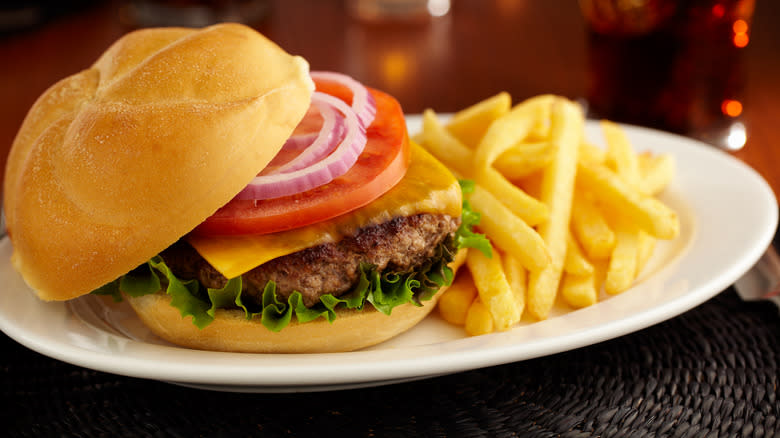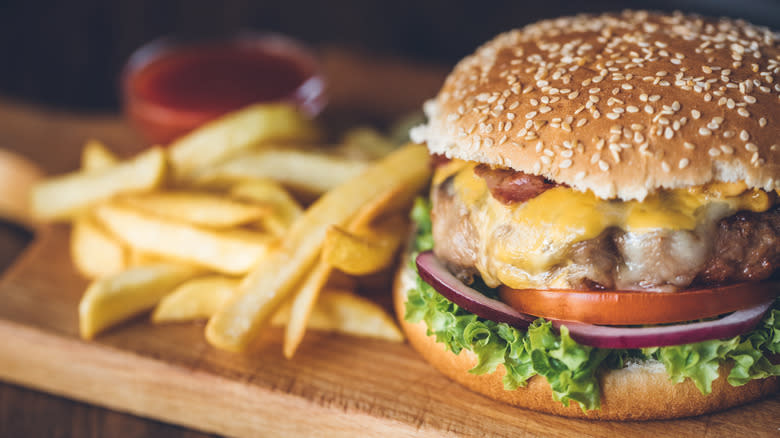How Burgers And Fries Became The Symbol Of Classic American Food

The burger world has progressed a lot since the ancient Mesopotamians domesticated cattle roughly 10,000 years ago. Today, American foodies put away an average of 50 billion burgers each year, and the burger-and-fries combo has taken on a life of its own as an icon of both American nostalgia and current national identity (especially with American cheese, which ironically originated in Switzerland). But, how did the combo rise from ground beef and spuds to a cultural symbol?
Modern American burger lovers might have German immigrants to thank. When the political revolutions of the German Confederation of 1848 hit, Germans immigrated en masse to the U.S. and brought chopped cooked beef called "frikadellen" with them. The dish was commonly served on a plate with potato salad, making it a proto-burger and fries. The name "frikadellen" was Americanized to "Hamburg style" chopped steak, and was considered an ethnic German-American food for a time. By 1867, New York doctor James H. Salisbury was prescribing cooked beef patties for digestive issues (Salisbury Steak fans, rise up).
The bun didn't enter the picture until the tail end of the 1800s. Some historians speculate that the hamburger's move toward bread was inspired by another meaty American classic: The hot dog. Hamburger buns are speculated to have started in fair stands and roadside diners, particularly in Ohio, Wisconsin, New York, Texas, and Connecticut, and all the states could probably make a case for why they were the first to do it: It was likely happening everywhere at the same time.
Read more: 23 Types Of Potatoes And When To Use Them
Thrifty, Tasty, And Timeless

The hamburger's formal debut arrived at the 1904 World's Fair in St. Louis, and meat grinders entered the home appliance market during the early 1900s. It wasn't long before fast food chains and industrial meat-processing plants began cropping up and mass-producing ground beef patties. The first White Castle restaurant opened in Kansas in 1921, lauded for being easy, filling, convenient, and inexpensive, and paving the way for fast food burgers to come. Other now-dominant burger chains followed quickly, with McDonald's and In-N-Out Burger in 1948, Burger King in 1954, and Wendy's in 1969. So, when did fries enter the scene?
Fries have a French-Presidential origin in America. French Army pharmacist Antoine-Augustin Parmentier was reportedly a huge fry fan known to host 20-course potato-themed dinner parties at his estate -- and at one such party, Benjamin Franklin and Thomas Jefferson may have been in attendance. Inspired, the politicians may have brought fries back with them to America. A recipe handwritten by Jefferson survives for pommes de terre frites à cru en petites tranches, or "potatoes deep-fried while raw, in small cuttings."
Recipes for French fried potatoes were cropping up in the 1800s, and during World War I, fries were a cheap and popular way to prepare potatoes. Then again during World War II, White Castle (which by this point was cruising in Kansas) needed an affordable, filling menu offering with a hardy shelf life to satiate the masses and withstand wartime food rationing restrictions. Fries had officially entered the burger scene and they were here to stay.
Read the original article on Tasting Table.

